Goji Berries - USDA Certified Organic
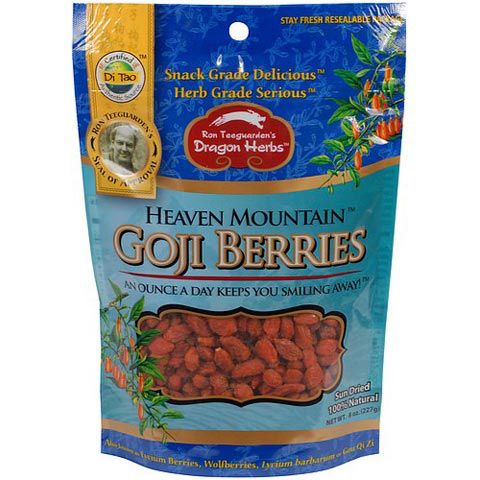
click to enlarge
Goji Berries - USDA Certified Organic
Wilderness Family Naturals
Raw, Wild, Certified Organic* sun-dried whole Goji Berries!
Certified Organic Goji Berries (Wolfberries)
Raw, Wild, Certified Organic* sun-dried whole Goji Berries!
*USDA certified organic by ICS (International Certificate Services)
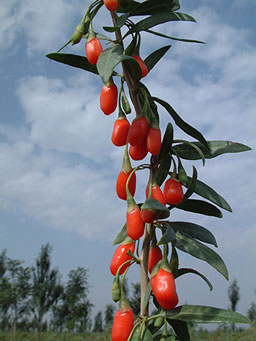
 Wilderness Family Naturals’ Goji Berries are gathered from plants growing in the Ningxia province of China. The berries are dried naturally by the sun. They are not fumigated, sweetened, or adulterated in anyway.
Wilderness Family Naturals’ Goji Berries are gathered from plants growing in the Ningxia province of China. The berries are dried naturally by the sun. They are not fumigated, sweetened, or adulterated in anyway.These whole, naturally-sun-dried goji berries are about the size of a raisin. They are not as sweet as raisins, but they are not as tart as sour cherries or cranberries. There is no fruit in the American diet (that I know of) that tastes similar to a goji berry .
Goji berries are bright red and the plants often reach 12 feet tall. These plants are native to China and Tibet.
All goji berries imported into the United States are sold as a dried berry. The harvest occurs in the fall (October) and berries are sun-dried to preserve them, so they can be used until the next harvest. The lower the moisture content, the better their preservation.
Goji berries readily re-hydrate when added to water. The goji berry, native to China and Tibet, has been highly regarded for centuries for its nutritional value. It is found in many, many ancient books from the region. These berries contain anti-oxidants and other important nutrients.
A Great Goji Idea!
"I have been enjoying your wolfberries. A Chinese friend of mine likes to put 4 or 5 wolfberries in his tea. They hydrate in the tea, add a tiny bit of sweetness, and are lovely to eat when you get to the bottom of the cup."
Now USDA Certified Organic!
Buy Certified Organic Whole Goji Berries (From Ningxia)
More Detail
Goji Berry Recipe Suggestions
How do I use Goji Berries?
In China and Tibet the berries are usually eaten raw or made into teas and soups. If you look for Asian recipes using the dried berries you will find such things as chicken soup that contain goji berries or a warm hot grain cereal that has goji berries added to it. Asians often make a tea by boiling herbs and the goji fruit in water.
If you look at recipes from the U.S. you will find recipes that call for the goji berries to be soaked overnight (or even for 15-20 minutes to soften them) and whipped in a blender in the morning. This “goji puree” is then the base for a smoothie or delicious drink.
Here are examples of Chinese Goji Berry Soups :
Chinese Wolfberry & Sea Bass Soup
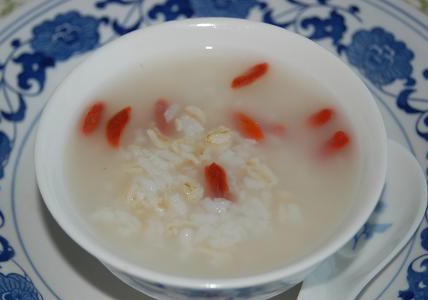
1 sea bass (any fish seems to work)
½ cup goji berries (wolfberries)
1 pound mushrooms
1 scallion, chopped
5 slices of fresh ginger
5 cups of broth
Salt (use a natural mineral-rich salt, if you can)
5 Tablespoons rice wine
1 teaspoon hoisin sauce
- Smear fish with 1 tbsp of rice wine and a little salt.
- Add in the wolfberries, button mushrooms, scallion, ginger and hoisin sauce.
- Boil the stock in a separate medium to large sauce pan.
- Place the seasoned fish into the sauce pan containing the stock.
- Simmer the soup until the fish is done (about 20 minutes)
- Add rice wine and salt to season before serving.
Sizzling Rice Soup
In this delicious soup, the crispy rice crackles and pops in the hot soup just before serving. Serves 6 people
Ingredients:
1/2 cup dried black mushrooms, stems removed
1/2 cup gou qi zi (dried Chinese wolfberry)
1/2 cup chicken breast, sliced thin
1/4 cup spring onions
Boiling water
6 cups chicken stock
1 cup mushroom stock (reserved liquid from soaking the dried mushrooms)
1/4 cup bamboo shoots, sliced thin
1/2 cup snow peas (can substitute frozen peas)
1/4 cup fresh shrimp, shelled, deveined, cut into quarters
1 teaspoon salt
1 tablespoon light soy sauce
1 tablespoon sesame seed oil
Crispy rice (See Below)
Coconut Oil for deep frying
Directions:
Soak mushrooms in hot water for about 20 minutes. Strain the liquid and reserve 1 cup. Cut mushrooms into quarters and set aside.
Bring water to boil. Put in chicken and pork. Cook until the color changes. Rinse in cold water. Drain.
Add the chicken stock to the reserved mushroom liquid in a saucepan and bring to a boil. Add the chicken, pork, mushrooms, and bamboo shoots. Then add the peas and shrimp. Bring to boil again. Season with salt and soy sauce. Add the sesame seed oil. Bring to a boil. Remove to a tureen or bowl.
Heat wok and add oil for deep-frying. When oil is ready, prepare the Crispy Rice. Deep-fry until it puffs and turns brown. Drain on paper towels.
At the table, slide the sizzling rice into the soup. The rice will make crackling sounds as it meets the hot broth.
To Make Crispy Rice
Preparation Time: 1 1/2 hours
Yield: 8 - 10 squares
Rinse 1 cup of long or medium grain rice.
In a pot, add 1 1/2 cups water (1 1/4 cups for medium grain rice) to the rice and bring to a boil.
Cover and simmer on low heat for 30 minutes. Remove from burner and allow to cool.
While rice is cooling, preheat oven to 300 degrees Fahrenheit.
Place the rice on a baking sheet, making sure that it is about, but no more than, 1/4-inch thick.
Bake the rice for 50 - 55 minutes, until it is dry. Cool and cut into 2-inch squares. Store in a canister until needed. Do not freeze.
Trail Mixes
Goji berries also go very well with coconut chips and soaked dried nuts. People use this combination for home-made snack bars, trail mixes, granola, and other snacks.
Goji berry Juice
To make your own Goji berry juice drink here is a basic recipe:
1/4 cup goji berries
2 cups pure water
1. Soak berries in water for 4 hours or more, overnight is fine.
2. Blend in blender until well blended.
Optional: 1/4 cup fresh blackberries, raspberries or blueberries can be added to the puree. You can also add other fresh fruit such as apple, mango and/or banana. If you use just the goji berries you will have a nice, nutritious goji berry juice. If you add additional fruit you will have a great smoothie. Most goji juice companies utilize berries which are low in carbohydrates and high in antioxidants such as blueberries and raspberries in their concotions.
If the above juice is not sweet enough for you or your family you may want to add a little natural, raw honey or raw agave syrup. Another option is to soak the goji berries with dried dates or raisins. this will make the juice darker and sweeter.
Lychee Ice Jelly With Wolfberries
For those with a sweet tooth, try this recipe and cool down on those hot Summer days. Easy to make too!
Ingredients:
1/2 tsp (2g) crystal jelly konnyaku powder
1/2 tsp (2g) ice jelly powder (Ai Yu Jelly Powder)
60g sweetener of choice
450ml water
10 wolfberries, soaked till softened
1 can fresh lychee
150ml canned lychee syrup
1 1/2 tsp lemon juice
Method:
1. Combine crystal jelly Konnyaku powder and 35g sugar well and set aside.
2. Combine ice jelly powder and 25g sugar well and set aside.
3. Strain lychees to collect syrup and set aside.
4. Bring water to boil, add in crystal jelly mixture and boil for 3 minutes. Followed by add in ice jelly mixture, stir till boiling before turn off the heat.
5. Add in lychee syrup and lemon juice and mix well.
6. Place wolfberries and lychees into individual glasses, pour cooked mixture and let it cool and solidify before transfering to the refrigerator. Quality Control Standards & How The Best Berries Are Selected
How to Select a High Quality Goji Berry
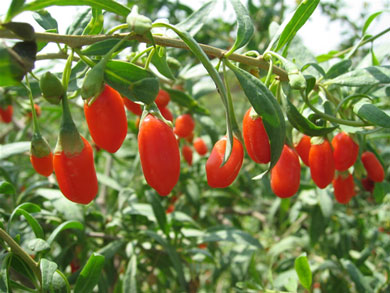 Lycium barbarum is the genus of species (Latin Name) for the true goji berry. This berry predominantly grows in an area called the “goji belt” that is found in northern China and some mountainous areas of Tibet. Nature does not recognize political boundaries so the actual country is not as important as the soil and climate conditions.
Lycium barbarum is the genus of species (Latin Name) for the true goji berry. This berry predominantly grows in an area called the “goji belt” that is found in northern China and some mountainous areas of Tibet. Nature does not recognize political boundaries so the actual country is not as important as the soil and climate conditions. In other areas of China a very similar berry called Lycium chinensis is also grown. The nutritional benefits of Lycium barbarum are believed to be superior to the Lycium chinensis.
Wilderness Family Naturals' Goji berries currently come from Ningxia China. In the book Goji: the Himalayan Secret by Dr. Earl Mindell, R.Ph. M.H., Ph.D. there were three areas where he found the highest quality goji berries. He based his conclusions on research using an FT-IR spectrometer. An FT-IR uses light waves to excite bonded atoms coupled with highly sophisticated mathematical formula to get a fingerprint of the organic molecules found in the substance. Dr. Mindell collected berries from well known goji growing regions in Asia: Ningxia, Xinjiang, Gansu, Tianjin Shi, Qinghai, Shanxi, Inner Mongolia, Sichuan, and Tibet.
Using the FT-IR they found one group of nutrients that set a few of the regions apart from the rest. All the goji berries had high amounts of carotenoids and antioxidants. They all had high levels of vitamin C and beta carotene. But a few of the regions had goji berries that also contained large amounts of bioactive polysaccharides, also called proteoglycans.
Proteoglycans are a family of complex carbohydrates that are bound to proteins. They are produced by this plant as a defense mechanism. It is believed by researchers that goji berries are one of the richest sources of glyconutrients.
Dr. Mindell also found that growing seasons with less sunlight or rainfall and years with abnormally low summer temperatures yielded less glyconutrients. Conversely, no matter what area they came from, exceptional growing seasons will yield higher amounts of glyconutrients. However, Dr. Earl Mindell found that the berries in Ningxia and Xinjiang consistantly had the highest levels of glyconutrients each year. In Ningxia and Xinjiang glyconutrients were always present, regardless of the growing season. The FT-IR peaks representing the glyconutrients did vary depending on the growing season. It appears to be the combination of the unusually alkaline soil (pH 8.2-8.6) and the extreme temperature fluctuations from 102 to -16 degrees F along with adequate rainfall that produces the best berries.
Goji berries sold out of the “goji belt” are available in 4 grades. These 4 grades are “super”, “king”, “special”, and “grade A”. The most expensive and the largest are the “super” grade. “Super” grade berries are 41% more expensive than “grade A”. To be classified as this size there are approximately 240 berries per 50 grams. By contrast there are approximately 480 grade A berries per 50 grams. The largest berries are produced by the longest established bushes/vines. The longer established the bushes, the better quality the berry. This is very much like grapes used to make wine.
Our producer uses natural, sun drying. No artificial heat is used. Optimal dryness for our berries is approximately 11.0% moisture content. This ensures a tasty, ready to eat berry with a long shelf life. Goji berries are harvested during a six week period in the fall. These berries must be dry enough to keep until the next harvest. Prior to selecting our producer we sampled goji berries from a number of suppliers. Since that time we have sampled even more. The berries of most companies in the US had higher moisture content than the ones we have selected. The higher moisture content berries all tasted fermented as the year progressed and by August I could find no moist plump goji berries that did not taste fermented. In contrast the drier berries, such as the ones we carry, even after 2 years of storage did not taste fermented. This is why we have chosen the drier berry. They readily plump up if soaked in water and can be blended into a goji puree easily. They also soften quickly when put into soups or cooked cereal (like oatmeal), yet they store very well. Even though there is so much you can do with goji berries, most people in the US just eat them as they are.
In recent months, it has been brought to our attention that many companies who produce moist goji berry use sulfur dioxide or sodium metabisulfite to retard the fermentation process. Although the manufacturers and importers declare there is no sulfur on their product, laboratory testing has proved otherwise. We have had our berries tested and have verified there is no sulfur dioxide on them. The low moisture content (11%) naturally preserves the berries without a need to use chemicals.
Goji Berries - The Difference Between The Chinese & Tibetan Varieties
Goji Berry or Wolfberry? Tibet or China? Which Is Better?
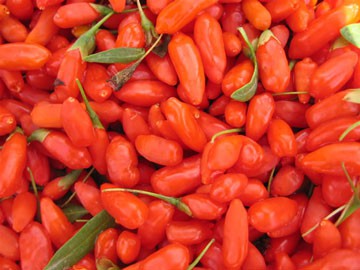 There are websites who have wolf berries and websites who have goji berries. Some claim they have only wolf berries which are far superior to goji berries and many claim that the goji berries are the only true health-promoting, high anti-oxidant wild berry of China. In trying to understand where the truth lies, my investigation began with the genus and species of these plants. Any plant with the same genus and species is the exact same plant. When the plant is even just slightly different it is given a different species. All plants of the same genus species can cross pollinate, they can live wherever other plants of that same genus and species are found and they are indistinguishable.
There are websites who have wolf berries and websites who have goji berries. Some claim they have only wolf berries which are far superior to goji berries and many claim that the goji berries are the only true health-promoting, high anti-oxidant wild berry of China. In trying to understand where the truth lies, my investigation began with the genus and species of these plants. Any plant with the same genus and species is the exact same plant. When the plant is even just slightly different it is given a different species. All plants of the same genus species can cross pollinate, they can live wherever other plants of that same genus and species are found and they are indistinguishable.There are however, subspecies. The goji berries from Tibet that grown in the wild are technically Lycium barbarum just like the goji berries that grow in the goji belt in China where Ningxia province is found. Goji berries from Tibet and the Goji belt will be called Wolfberries by some and Goji berries by others.
The real difference, most likely comes from variations between climate and soil fertility where the plants grow.
Goji bushes are in the Solanaceae family which also includes the tomato, green pepper, eggplant and potato.
Lycium Barbarus (Also Known As Lycium Barbarum)
Lycium barbarus grows in various regions of Asia such as Tibet and Inner Mongolia but also thrive in an area called the “goji belt”. There are several provinces of China and areas in Tibet where these vines grow in the wild.
The goji berry plant likes a soil that is slightly alkaline (pH of 8.2 to 8.6) and very fertile. Temperatures in the mountains can get very cold and very hot (102 degrees F to 16 degrees F.) It is this type of soil and climate that grows the largest, plumpest, most beautiful goji berries. The fruits are a deep red color, contain few seeds and have an exquisitely sweet taste.
So Are Goji Berries From One Area Better Than Goji Berries From Another Area?
Dr. Earl Mindell, R. Ph. M.H., PhD. headed up research using the FTIR to compare goji berries from all the Goji producing regions of China and Tibet. His conclusions are that for the most part all goji berries from anywhere within the “goji belt” are very, very similar. Of course, there are fluctuations from year to year, depending on rainfall, sunshine and temperatures. However, he did find for the most part goji berries growing in fertile valleys amongst the mountains had higher peaks and some extra peaks. On his FTIR scans he identified the substances causing these peaks and glycol-nutrients, predominantly glycosides or polysaccharides.
It is Dr. Mindell’s opinion that consistently there were three regions that showed higher FTIR peaks and larger berries than all the other regions. These regions were Ningxia China, Xinjiang China and areas of Tibet in the Himalayan Mountains. These 3 regions alone showed the most dramatic FTIR peaks and richest amount of phytonutrients. See Dr. Mindell’s book: Goji, The Himalayan Health Secret.
About Wilderness Family Naturals
Wilderness Family Naturals is here to serve you from the pristine wilderness of Northeastern Minnesota. We are located on the North Shore of Lake Superior at the edge of the Superior National Forrest, in an untouched, unpolluted land teaming with wolves, moose, beaver and bald eagles. This area of the United States has some of the purest water and freshest air in the entire country and the soil here has never been depleted by farming or contaminated by industry. For over 20 years Ken and Annette have purposed to live clean healthy lives, believing that a diet with nutrient dense foods is key.
Initially, Wilderness Family Naturals began in the home of Ken and Annette Fischer, 20 miles from phone lines, electric lines, septic systems, indoor plumbing or plowed roads. In 2000, from the peace and quiet of the wilderness and with the help of their children, they began supplying healthy, nutrient dense foods over the internet. For the first 3 years WFN, which began as a simple family business, grew substantially as they worked to bless people with healthy foods and supplements.
Soon they were forced to move to a small town about 20 miles away where they could have UPS and US mail service and the ability to hire employees. Today, Wilderness Family Naturals is in the neighboring town of Silver Bay, MN and employs close to 30 people. It is still run by Ken and Annette Fischer; however, many wonderful people from the surrounding community come each day to help serve you.
Wilderness Family Naturals was created to help anyone who is looking for high quality, healthy food.
